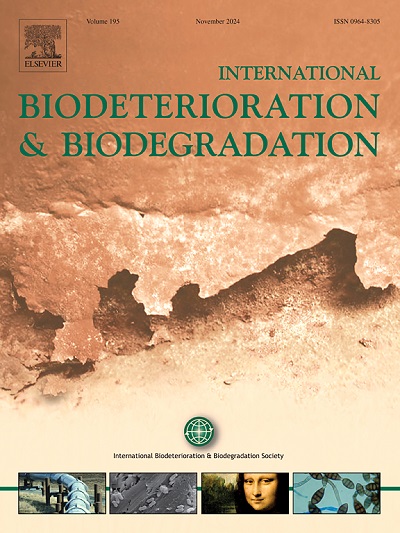Microbial reductive dissolution of schwertmannite leading to antimony release
IF 4.1
2区 环境科学与生态学
Q2 BIOTECHNOLOGY & APPLIED MICROBIOLOGY
International Biodeterioration & Biodegradation
Pub Date : 2025-06-09
DOI:10.1016/j.ibiod.2025.106133
引用次数: 0
Abstract
Schwertmannite, an iron hydroxysulfate mineral, significantly influences the mobility of antimony. While schwertmannite can effectively sequester antimony through adsorption or coprecipitation, the subsequent release of antimony from schwertmannite via microbial activities remains poorly understood. This study revealed that up to 40% of the Sb(V) coprecipitated by schwertmannite can be released by the iron-reducing bacterium Shewanella piezotolerans WP3 through dissimilatory iron reduction, Over 50% of crystalline Fe(III) in schwertmannite was reduced by WP3, facilitating the dissolution of schwertmannite and the release of Sb(V), accompanied by partial Sb(V) reduction to mobile Sb(III) (3.10–3.34% of total Sb). Vivianite emerged as the predominant secondary mineral in the presence of WP3 as confirmed by XRD spectra. In contrast, under the pH around 6.8 (mimicking the circumneutral condition during antimony remediation) in abiotic control, Sb(V)-loaded schwertmannite remanded relatively stable with 2.13–3.04% Sb(V) released. These findings underscore the critical role of microbial Fe(III) reduction in mobilizing antimony from Sb-bearing minerals, thereby highlighting potential contamination risks associated with microbial activity.

schwertmanite的微生物还原溶解导致锑释放
Schwertmannite是一种羟基硫酸铁矿物,对锑的迁移性有显著影响。虽然schwertmannite可以通过吸附或共沉淀有效地隔离锑,但随后通过微生物活动从schwertmannite中释放锑的机制尚不清楚。本研究发现,施魏特曼石共沉淀的Sb(V)中,高达40%的Sb(V)可被压耐雪瓦氏菌WP3通过异相铁还原释放,施魏特曼石中超过50%的结晶Fe(III)被WP3还原,有利于施魏特曼石的溶解和Sb(V)的释放,并伴有部分Sb(V)还原为可移动的Sb(III)(占总Sb的3.10-3.34%)。XRD谱图证实,在WP3存在的情况下,橄榄石是主要的次生矿物。相比之下,在pH为6.8左右(模拟锑修复过程中的环中性条件)的非生物对照中,加载Sb(V)的施特曼石保持相对稳定,Sb(V)的释放量为2.13-3.04%。这些发现强调了微生物Fe(III)还原在从含锑矿物中调动锑方面的关键作用,从而强调了与微生物活动相关的潜在污染风险。
本文章由计算机程序翻译,如有差异,请以英文原文为准。
求助全文
约1分钟内获得全文
求助全文
来源期刊
CiteScore
9.60
自引率
10.40%
发文量
107
审稿时长
21 days
期刊介绍:
International Biodeterioration and Biodegradation publishes original research papers and reviews on the biological causes of deterioration or degradation.

 求助内容:
求助内容: 应助结果提醒方式:
应助结果提醒方式:


